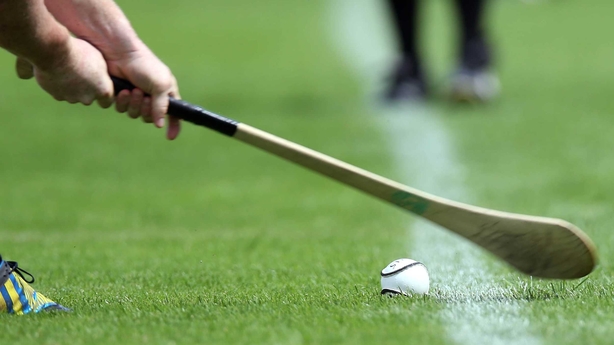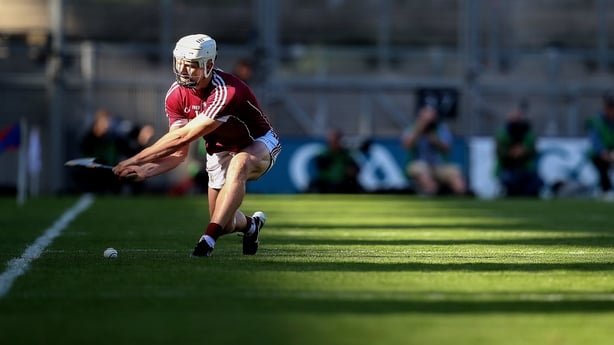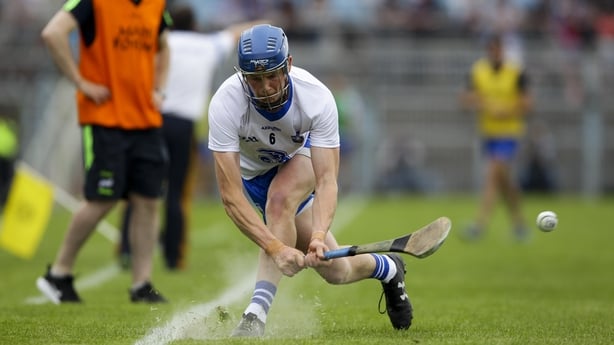When Cork and Clare met in the Munster senior league in Ennis at the end of December, Cork’s Declan Dalton stood over a sideline cut in front of the north stand in the 57th minute.
Dalton was about 40 metres from goal but, with the rain lashing down, and striking from his left side, Dalton drifted the sliotar over from the right touchline.
It was a superb point in the conditions, but the score was even more impressive considering it is one of the most difficult skills to execute, and a score rarely seen from a striker cutting infield on his left side.
Trying to cut the ball from left to right, for a player striking on their right side, is more difficult than taking a sideline cut from right to left because it requires a degree of curl and power to draw the shot in.
That may appear to be no harder than a player taking a sideline striking on their left side, and trying to cut the ball from right to left. But it is because those attempts have rarely been scored, which is what made Dalton’s score so unique.
Another reason is because most players are strongest on their right side. That has been reflected in the style of almost all of the great freetakers of the last 20 years; Joe Canning, Henry Shefflin, Eoin Kelly, Patrick Horgan, Seánie McMahon, Johnny Dooley, Gary Kirby, DJ Carey, Paul Flynn, Pauric Mahony.

Growing up, Jamesie O’Connor was always strongest off his left side but when he began taking frees with Clare at inter-county level, he hit them off his right side.
Of course, there were, and still are, some notable exceptions of excellent freetakers striking off their left side. Pat Fox was one while TJ Reid is one of the best in the history of the game but there were plenty of quality takers before, and after them, with a similar style (albeit with their right hand on top of the hurley); Paul Codd, Ger Farragher, Paul Ryan, Shane Dooley, Tony Kelly, Aaron Gillane.
Apart from Reid, the most effective left sided (striking) sideline cut specialist in the game now is Mark Coleman. He and Tony Kelly scored brilliant sideline cuts in the 2018 championship.
Sublime stickwork from Mark Coleman for this sideline for @OfficialCorkGAA pic.twitter.com/h2aGvV0Cg6
— The GAA (@officialgaa) July 4, 2018
Coleman bagged three (which has taken his championship tally to five) but Canning nailed five points from sideline cuts last summer, which copper-fastened his status as the game’s greatest practitioner of the art; Canning has now scored 20 points from side-line cuts in the championship, 12 points more than any other player.
Canning has been so good at the art that he altered convention and changed the way players and managers looked at the game because conceding a sideline against him was almost like giving up a score.
A practise that was once considered unique is now common in the modern game; in last year’s Tipperary-Limerick league semi-final, Ronan Maher nailed a sideline from 80 metres. It was the best sideline cut seen since Canning landed an Exocet from out near Holycross against Cork in 2008.
The power, the distance, the strike. What a Sideline from Ronan Maher! pic.twitter.com/Hy7GYm0nwr
— The GAA (@officialgaa) March 31, 2018
The expert GAA statistician Leo McGough once showed how, prior to the 2010 All-Ireland final, there had been just seven points scored from sideline cuts in the history of All-Ireland finals. Yet there have been six points scored from sidelines in the last nine finals.
The art has definitely become more common now but, apart from a select few sideline cut experts, is the skill tailing off? Or have attitudes changed towards the practise?
"In their championship history, Kilkenny have scored just 1-10 from sideline cuts"
Stats from Sure, the official statistics partner of the GAA, showed up some very interesting numbers at the end of last year’s championship. From 2012-17, the success rate of shots from a sideline cut was just 22.6%. In 2018 though, that figure had dropped to 17.6%.
Last season’s numbers may have just been a blip but the flipside to those statistics is that a lot of teams are playing the percentages more now, by minimising risk and ensuring that the ball is kept in play. That has always been Kilkenny’s principle; in their championship history, Kilkenny have scored just 1-10 from sideline cuts.

The fact that Canning has scored nine more sidelines in his career than Kilkenny further underlines his mastery of the skill.
Yet there are plenty of other outstanding practitioners of the art in the current game; Reid, Coleman, Kelly, Austin Gleeson, Darragh Fitzgibbon, Ronan Maher, Jason Forde, John ‘Bubbles’ O’Dwyer, Noel McGrath, Peter Duggan, Darragh O’Donovan, Cathal Dunbar.
With Tipperary having five specialists (Brendan Maher is also well able to score from sidelines), it’s no surprise that their players have often argued for two points to be awarded for a sideline cut. "It’s such a unique skill," said Seamus Callanan last week. "A lot of good players have the ability to do it at the moment. It’s definitely something I think should be rewarded."
"It's such a piece of skill and the crowd gets so much out of it. If it was worth two points it would give such a lift"
Brendan Maher made a similar point last year. "It's an unbelievable skill and there is that debate, 'Should it be two points?" asked Maher. "I think that skill could be rewarded. I'd love to see it being trialled even in the league to see if it would add a little bit of spice to the game. It's such a piece of skill and the crowd gets so much out of it. If it was worth two points it would give such a lift. It’s definitely worth trying."
The GAA have tried it before, during the 2005 league, when two points were awarded for a sideline cut. The numbers suggested that it worked; in 49 Division One League games in 2004, there were only four points scored from sideline cuts; in 49 games in the 2005 league, ten sideline cuts were landed.
Yet in March 2005, the Hurling Rules Task Force decided not to submit a motion to Congress seeking to double the reward for points from sidelines, primarily because it could not drum up enough support.
In 2010, a motion to Congress from Tipperary club, Toomevara, and a similar one from Armagh, recommended that two points be allowed for each score from a sideline cut. Congress turned it down.
Camogie changed its rules in 2012 to allow two points for a sideline cut but there has always been a strong body of opinion that feels two points is excessive reward for an uncontested shot from distance in hurling. Yet a significant number of players have long been in favour of having two points for a sideline cut.

When more than 30 inter-county players and managers were interviewed for a book called ‘Hooked On Hurling’, which was produced last year by five girls from a Transition Year Mini Company in St Mary’s Secondary School Nenagh, most of the interviewees favoured two points for a sideline cut.
"It’s a skill I think should be showcased more with the likes of Joe Canning, Mark Coleman and ‘Bubbles’ O’Dwyer almost perfecting them," said Austin Gleeson.
There will always be arguments against any such rule change.
Picture the scenario; the attacking team, which are a point down, have a late sideline cut, not just to draw the game, but to win it. The defending team have heroically tried to hold out but, even though they haven’t fouled, they are now powerless to a sideline cut expert. If it was a penalty in a similar situation, where the defending team was leading by two points, at least their goalkeeper would have a chance to save it.
On the otherhand, what if the rule was amended whereby two points could only be allowed for a sideline cut from a certain range, say a 55-metre mark on both sidelines? Picture a team being down by one or two points in the dying seconds of a big championship match and deciding to go for broke from a sideline cut from distance.
Imagine the spellbinding drama then?

